AM2 Motherboards-Part 4: ATI Crossfire Xpress 3200
by Wesley Fink on August 21, 2006 7:00 AM EST- Posted in
- Motherboards
Gaming Performance
We tested with our recently revised group of game tests, which includes Call of Duty 2, Serious Sam 2, Half Life 2: Lost Coast, F.E.A.R, Far Cry, and Splinter Cell: Chaos Theory. All boards were tested with the NVIDIA 7900 GTX using NVIDIA 91.31 drivers. The ATI chipset boards were additionally tested with a single ATI X1900 XTX using the Catalyst 6.7 drivers. We are experimenting with a new benchmark for Prey to see if it is useful for motherboard comparisons. Results of the MSI K9A and ECS KA3 running the Prey Benchmark 1.1 are included in the game benchmarks.
Beginning with this review, we have upgraded our Serious Sam 2 benchmarks to more repeatable and consistent benchmarking by using the HOC Serious Sam 2 benchmark. Results with this test are not directly comparable to older SS2 test results, so we used this opportunity to upgrade our test setup to HDR. HDR is more demanding of graphics capabilities and generally yields lower FPS performance than standard SS2 tests. Since results are not comparable to earlier test results, SS2 HDR results are only reported for the MSI K9A and ECS KA3. We also have comparative results in SS2 without HDR.
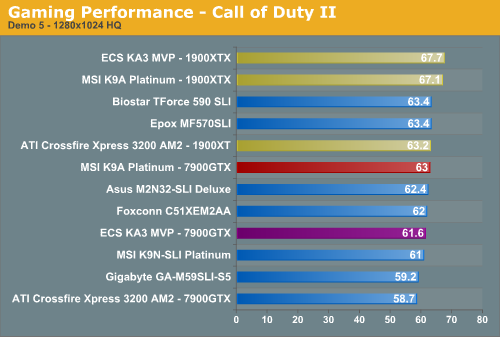
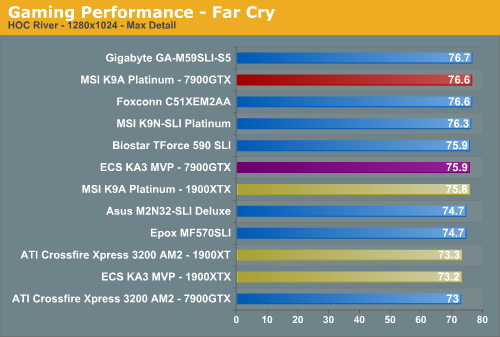
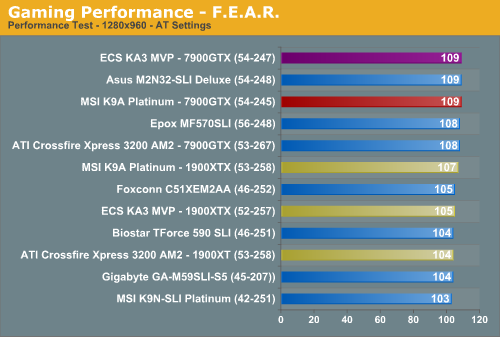
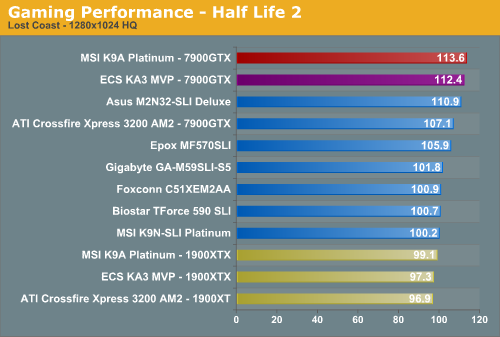
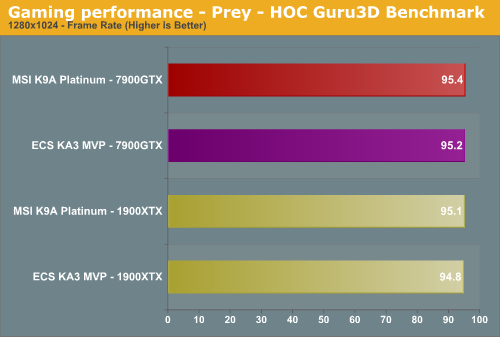
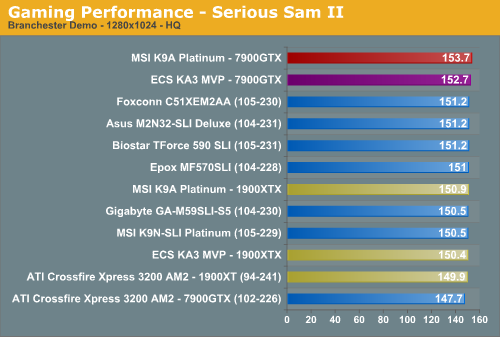
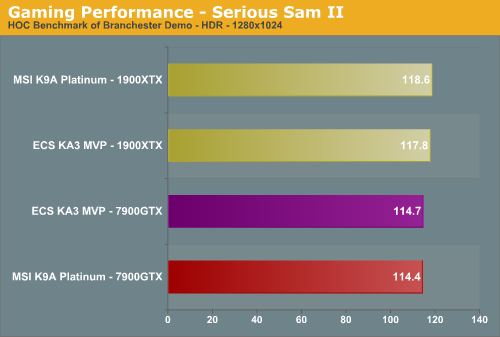
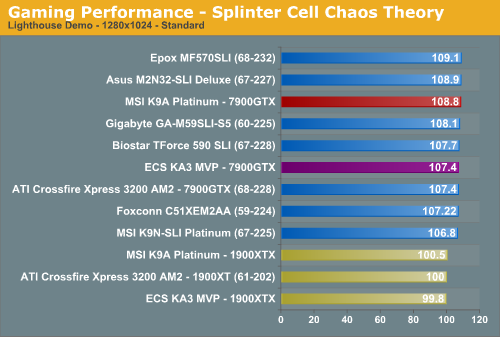
Our benchmark comparisons throughout this four-part AM2 review series have used the NVIDIA 7900 GTX for comparison. We have also included results on the ATI chipset motherboards for the single ATI X1900 XTX. These ATI results are for REFERENCE ONLY and are color coded in pale gold for easy reference. With the NVIDIA 7900 GTX the MSI K9A Platinum results are in red and ECS KA3 results are in purple (to match the board).
The MSI placed at or near the top of the performance charts in all games, whether comparing 7900 GTX or 1900 XTX performance. The ECS was an average to above average performer. In Standard gaming benchmarks the MSI K9A, ASUS M2N32-SLI and Epox MF570SLI were normally always in the top half in performance. From a broader perspective, it is interesting to see that the ATI 1900 XTX and NVIDIA 7900 GTX are fairly well matched in overall performance. Each GPU has certain games in which it is best, but overall the wins and losses are well balanced on each side at standard 1280x1024 resolution with eye candy turned off.
SLI/CrossFire Gaming Performance
ATI and NVIDIA both have flagship Dual X16 solutions. SLI and CrossFire are about gaming, so dual video tests were confined to gaming benchmarks, and the test suite is heavily slanted to recent and popular titles where SLI and CrossFire make the biggest difference. All dual video testing was at 1600x1200, 4xAA/8xAF. Tests were also run with a single X1900 XTX at this same resolution. The single video high-res results on the ATI AM2 are in pale gold and the CrossFire results are in red for MSI, purple for ECS, and bright gold for ATI Reference.
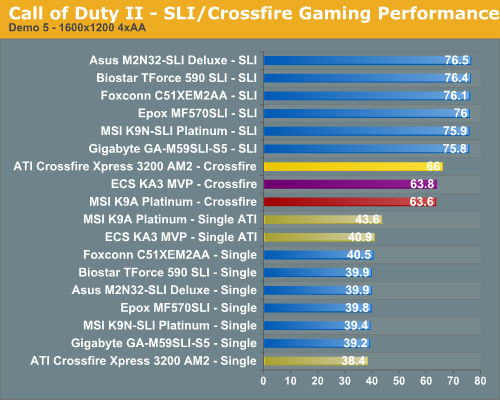
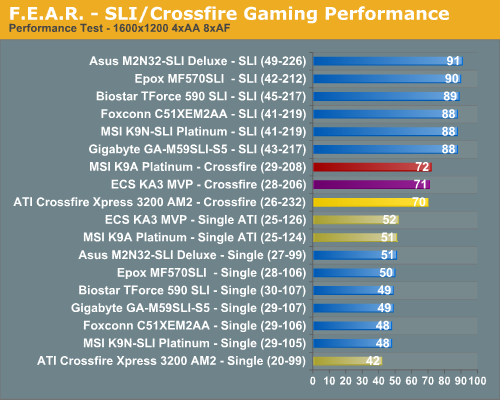
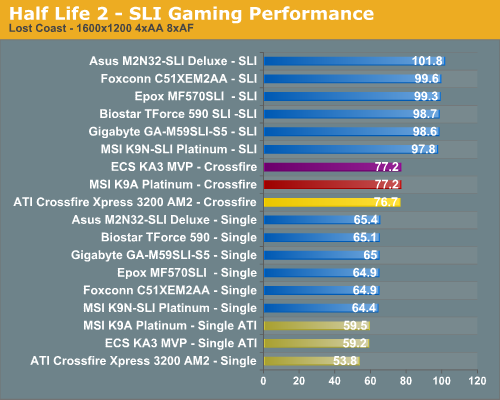
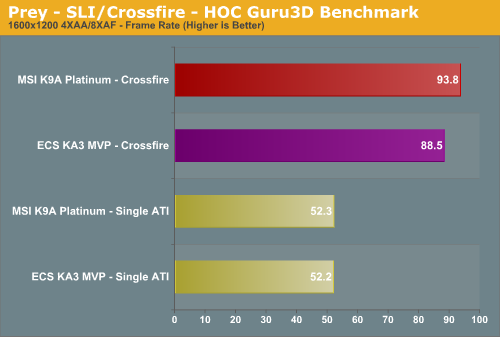
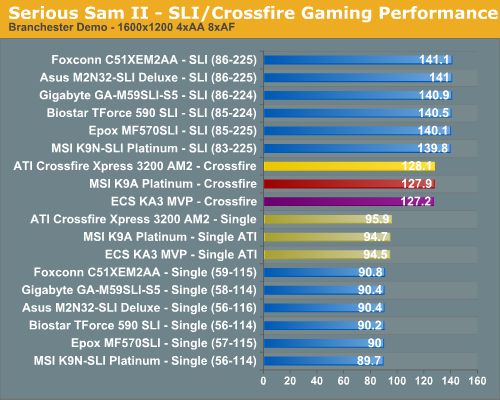
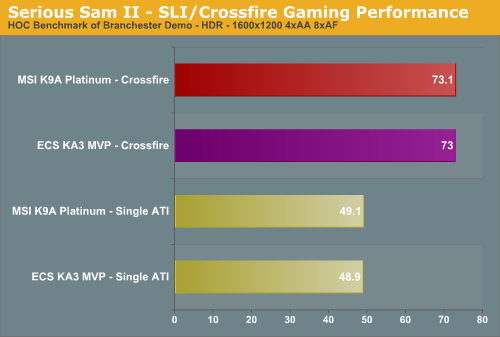
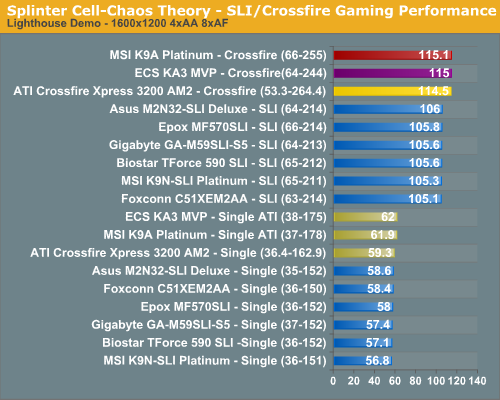
You might think you are looking at results from different video cards in CrossFire/SLI performance. Here leads are larger and positions are often switched from results at standard resolution without the eye candy. Among ATI Xpress 3200 boards the MSI stood out as a top performer. For NVIDIA nForce 500 based motherboards, the ASUS and Epox were normally at or near the top of the SLI performance charts.
We tested with our recently revised group of game tests, which includes Call of Duty 2, Serious Sam 2, Half Life 2: Lost Coast, F.E.A.R, Far Cry, and Splinter Cell: Chaos Theory. All boards were tested with the NVIDIA 7900 GTX using NVIDIA 91.31 drivers. The ATI chipset boards were additionally tested with a single ATI X1900 XTX using the Catalyst 6.7 drivers. We are experimenting with a new benchmark for Prey to see if it is useful for motherboard comparisons. Results of the MSI K9A and ECS KA3 running the Prey Benchmark 1.1 are included in the game benchmarks.
Beginning with this review, we have upgraded our Serious Sam 2 benchmarks to more repeatable and consistent benchmarking by using the HOC Serious Sam 2 benchmark. Results with this test are not directly comparable to older SS2 test results, so we used this opportunity to upgrade our test setup to HDR. HDR is more demanding of graphics capabilities and generally yields lower FPS performance than standard SS2 tests. Since results are not comparable to earlier test results, SS2 HDR results are only reported for the MSI K9A and ECS KA3. We also have comparative results in SS2 without HDR.








Our benchmark comparisons throughout this four-part AM2 review series have used the NVIDIA 7900 GTX for comparison. We have also included results on the ATI chipset motherboards for the single ATI X1900 XTX. These ATI results are for REFERENCE ONLY and are color coded in pale gold for easy reference. With the NVIDIA 7900 GTX the MSI K9A Platinum results are in red and ECS KA3 results are in purple (to match the board).
The MSI placed at or near the top of the performance charts in all games, whether comparing 7900 GTX or 1900 XTX performance. The ECS was an average to above average performer. In Standard gaming benchmarks the MSI K9A, ASUS M2N32-SLI and Epox MF570SLI were normally always in the top half in performance. From a broader perspective, it is interesting to see that the ATI 1900 XTX and NVIDIA 7900 GTX are fairly well matched in overall performance. Each GPU has certain games in which it is best, but overall the wins and losses are well balanced on each side at standard 1280x1024 resolution with eye candy turned off.
SLI/CrossFire Gaming Performance
ATI and NVIDIA both have flagship Dual X16 solutions. SLI and CrossFire are about gaming, so dual video tests were confined to gaming benchmarks, and the test suite is heavily slanted to recent and popular titles where SLI and CrossFire make the biggest difference. All dual video testing was at 1600x1200, 4xAA/8xAF. Tests were also run with a single X1900 XTX at this same resolution. The single video high-res results on the ATI AM2 are in pale gold and the CrossFire results are in red for MSI, purple for ECS, and bright gold for ATI Reference.







You might think you are looking at results from different video cards in CrossFire/SLI performance. Here leads are larger and positions are often switched from results at standard resolution without the eye candy. Among ATI Xpress 3200 boards the MSI stood out as a top performer. For NVIDIA nForce 500 based motherboards, the ASUS and Epox were normally at or near the top of the SLI performance charts.










28 Comments
View All Comments
mike6099 - Thursday, September 21, 2006 - link
The review does not list the ASUS M2N32-SLI as having raid 5. however, at newegg it lists that it does. does the ASUS M2N32-SLI indeed have raid 5 capability?dougcook - Friday, September 8, 2006 - link
Be careful with the MSI K9A. If you get one, you'll probably want to get a better chipset cooler for it.I bought an MSI K9A board (after reading this review). The 570 chipset seemed about right for me. Everything seemed ok (some things seemed a bit cheap, but nothing really unusual). There were reports about it being incompatible with some memory, so I was careful there and got the good stuff. I got it all installed and it looked like it was running fine...
For one day (until I actually tried to use it).
The first real thing I did was burn a few CDs. In the middle of the 3rd CD, the Northbridge overheated and the machine turned itself off. This happened 2 more times, and then the machine failed to boot at all (even after giving it time to cool off). I wasn't overclocking, and the box had decent ventilation. The CPU's temperature was fine, the GPU's temperature was fine, the case temperature was fine, but the chipset temperature was through the roof. I had to return the motherboard.
This may not happen for everybody, but looking on NewEgg, it seems that this has happened to many other people. The MSI northbridge does not have an adequate heatsink and is likely to burn up. Save the time and get something better. I got the equivalent ABit 570 SLI motherboard, and I've been very happy so far. I hear good things about the ASUS 570 as well.
Stele - Wednesday, August 23, 2006 - link
Great article! If only there were more Xpress 3200 boards on the market now... perhaps Anandtech would do a further roundup when that is the case?Good to see that most motherboard manufacturers are keeping that 24-pin ATX connector well at the edge. So far the only outstanding exception to this practice seems to be EpoX...
As for the 4-pin 12V connector, well, it may not be the best place to be for airflow and cable routing reasons, but that location is actually part of the ATX form factor specifications, which clearly states that the 12V connector should be "next to Voltage Regulator" (ATX Specification v2.2, pg 8). Motherboard designers likely just followed that to make life easier. Specifications aside, it also makes much engineering sense as it keeps traces short - crucial to maintain the quality of power supplied to something as important as the CPU VRM. Besides, airflow considerations are less of an issue with respect to four strands of wire.
IMHO perhaps the one improvement the designers could do while keeping with the spirit of the specifications would be to put the connector on the other side of the VRM, nearer the motherboard edge, though still at the I/O side of the motherboard instead of at the edges nearer the 24-pin ATX connector.
lopri - Wednesday, August 23, 2006 - link
Boy, do I love this article! Thanks to Wesley for this great review. Usually in previous AT motherboard reviews, many difficulties/bugs that end-users experience were often overlooked. (Warm-boot, Cold-boot, Vdroop(?), etc.) I sort of understood it as a result of working with motherboard manufacturers (It's been mentioned that they get BIOS updates on a daily basis), but I used to think AT's motherboard reviews were somewhat different from end-users' experience of retail products.This review feels much realer and it sounded almost like what I went through with a couple of the boards that I bought after reading AT reviews. I'm very glad and grateful, and hope AT keeps this critical viewpoints for future reviews, especially for motherboards.
lop
Le Québécois - Monday, August 21, 2006 - link
When you are talking about the SB600 featuresShouldn't it be: Athlon 64, Athlon 64 X2, Athlon FX, Sempron... To my knowledge Amd have Athlon 64 X2 ;) and even if the FX-60 (939) and the FX-62(AM2) have 2 core AMD still call them simply by FX and not FX X2.
JarredWalton - Monday, August 21, 2006 - link
Edited. Basically, SB600+RD580 supports all current 939/AM2 AMD CPUs. Not sure about SB460, as Wes specifically didn't list dual core and Opteron parts there. I would guess it does, but I will leave that edit to him just to be safe.Furen - Monday, August 21, 2006 - link
=)He just meant that FX X2 doesn't exist. There are A64s X2s and A64 FXes but even the dual-core parts are plain FXes.
mendocinosummit - Monday, August 21, 2006 - link
So, awards were handed out despite the fact that ASUS and other top mobo manus don't have ATI boards yet? Am I to assume that this is the end of the mobo lineup? I would really like to see at least two more boards featuring a ATI chipset; especially since the ECS board will basically be a flop at launch.Gary Key - Monday, August 21, 2006 - link
We also have a few mATX AM2 boards along with a couple of value solutions that we will be reviewing shortly. There is still the upcoming DFI 590SLI AM2 board to review also. :)yyrkoon - Monday, August 21, 2006 - link
Will you guys be testing any of the ABIT boards ? For me personaly, so far, my choice is the ABIT AN9 32x (non fata1ity). I like this board because it offers the SIL 3132 controller, and has an eSATA socket in the I/O section. This is, I'm hoping to use this board with a SATA port multiplier, for some external RAID 5 goodness :)